|
|
|
|
Cleromancy
An Introductory Guide
by Hebeloma Crustuliniforme
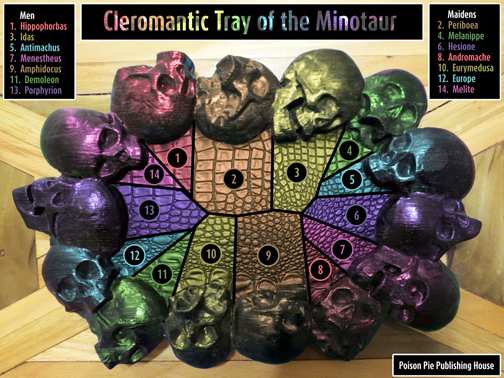
In contemporary times, in a day and age that we who live now describe as modern, the desire to predict the future resides within us no less than it did our forebears. Those among us who display a combined aptitude and interest for science and mathematics are routinely employed in the harnessing of knowledge to this end. The prediction of the daily weather or the longer-term climate is a topic of great interest both practical and speculative. No less interest is shown in the prediction of financial markets of all nations and products. Enormous resources of time and energy are consumed in the pursuit of predicting the rise and fall of the almighty dollar. Numerous other pursuits, from disciplines as diverse as national security, politics and sports, engage what divinatory means are at their disposal in an effort to gain, at the very least, a statistical advantage, relative to their adversaries or competitors, in the understanding of the future.
In these so-called modern times, much of the reliance on prognostication is placed in science and mathematics. It is as the ancients already knew and wrote in Ecclesiastes:
9What is it that hath been? the same thing that shall be. What is it that hath been done? the same that shall be done.
10Nothing under the sun is new, neither is any man able to say: Behold this is new: for it hath already gone before in the ages that were before us.
Thus, a talent for pattern recognition, well formulated by mathematical axioms, when applied to events evolving along a temporal axis, can yield a variety of prediction. Often these predictions are limited to general truths and trends, which are nevertheless of great practical utility.
Computers, the great machines of our age, are the engines of modern fortune-telling. As the French mathematician, Pierre-Simon Laplace (March 23, 1749--March 5, 1827) articulated:
We may regard the present state of the universe as the effect of its past and the cause of its future. An intellect which at a certain moment would know all forces that set nature in motion, and all positions of all items of which nature is composed, if this intellect were also vast enough to submit these data to analysis, it would embrace in a single formula the movements of the greatest bodies of the universe and those of the tiniest atom; for such an intellect nothing would be uncertain and the future just like the past would be present before its eyes.*
Thus, as the sheer power of computational capabilities expands, so too do the extent and breadth of the predictions grow. And yet, despite this great faculty for forecasting, we do not currently possess the ability to predict the human heart. Nor does such a skill appear on the horizon as an imminent likelihood. For that we must rely on the same fickle techniques employed by our ancestors, who practiced a rich variety of methods to unravel the future. Augury, or divination through the flight of birds, is a practice of which we have always been greatly enamored. Haruspicy, or divination through the examination of the entrails of sacrificed animals, is a technique we have always consciously avoided. In this document, we focus our attention on another technique of divination, namely cleromancy.
March 3, 2018
Wikipedia, the oracle of all contemporary knowledge, informs us that "cleromancy is a form of sortition, casting of lots, in which an outcome is determined by means that normally would be considered random, such as the rolling of dice, but are sometimes believed to reveal the will of God, or other supernatural entities."
Wikipedia is no less well informed on the subject of apophenia, the perception of intent in random or meaningless data. Common examples of apophenia include seeing a man or a rabbit in the surface of the moon, or hearing a message when an audio recording is played backward, or responding to tragedy with the sentiment, "Everything happens for a reason." The study of the various manifestations of apophenia is currently evolving into a science of its own.
With regard to divination via cleromancy, the accusation of potential apophenia is obvious. Cleromancy is a conscious, willful act of apophenia, seeking portents in random processes.
We admit apophenia. We embrace it because we associate the rejection of apophenia with the acknowledgment that we are purely biological organisms, limited to reacting to physical processes. Without pretense, we accept that we are governed by a relatively complex set of physical and chemical systems. It is also easy to admit without embarrassment that existence as a purely biological organism is unsatisfying, if not unpleasant. Since ancient times, people therefore accentuate existence with arbitrary decorations, such as morality, in order to construct a framework in which they can come to comfortable terms with the premise of their existence and their role within it. From this perspective, apophenia can play an important role. It helps create an environment where people can make peace with themselves and allow others to do the same. There is a great joy in what others might refer to as a deep self-delusion. In this document, it is our purpose to share that joy.
March 4 & 10, 2018
The most famous process for divination through cleromancy is described in the book, the I Ching, which scholars reliably date to the tenth century B.C. and which is still used today. The I Ching provides interpretations of sixty-four hexagrams based on the orientation of six randomly generated numbers between 6 and 9 inclusive. In the hexagrams, broken lines represented even numbers and solid lines odd. The historical means of generating these six numbers was based on the manipulation of fifty yarrow stalks (Achillea millefolium) and is known in detail. For the curious, we reproduce the procedure below.
Fifty yarrow stalks are used, though one stalk is set aside at the beginning and takes no further part in the process of consultation. The remaining forty-nine stalks are roughly sorted into two piles, and then for each pile one stalk is initially 'remaindered' then the pile is "cast off" in lots of four (i.e., groups of four stalks are removed). The remainders from each half are combined (traditionally placed between the fingers of one hand during the counting process) and set aside, with the process then repeated twice (i.e., for a total of three times). The total stalks in the remainder pile will necessarily (if the procedure has been followed correctly) be 9 or 5 in the first count and 8 or 4 in the second. 9 or 8 is assigned a value of 2, 5 or 4 a value of 3. The total of the three passes will be one of just four values: 6 (2+2+2), 7 (2+2+3), 8 (2+3+3), or 9 (3+3+3); that count provides the number of the first line.[1] The forty-nine stalks are then gathered and the entire procedure repeated to generate each of the remaining five lines of the hexagram. (Each succeeding line is written above its predecessor, i.e., the first line is at the bottom of the "stack" of lines, and the final, sixth line is at the top.)*
Other materials have also been used for divination via the I Ching, including generation of the numbers via coins, beads, rice grains, specialized dice and computer software.
March 18, 2018
Often have the words been said, "Not knowing is the triumph of evolution." Much that is otherwise unbearable in life is made bearable by the accidental fact that we never see it coming. It hits us unaware and, like any transient phenomenon, begins to diminish the instant it is over.
For those who subscribe to such an opinion, the appeal of cleromancy or any other technique of divination is difficult to ascertain. Ignorance of the future is one method to remain free of the misery of LaPlace's fatalistic determinism. We too adhere to this belief. We have no great desire to foresee the tragedy yet waiting to sunder our lives. Why then do we devote any time at all to the composition of an introduction to a topic so at odds with our own well-being? Who can say? Life is convoluted, as is the reasoning of living, organic beings. Here, we are engaged in a task detrimental to our peace of mind but nonetheless find a pleasant way to while away the hours, imagining the unraveling of time unarrived. In this fantasy, foreknowledge does not seem especially threatening. Were the entire endeavor to end in failure, we would not be discovered to be disappointed.
March 26, 2018
Before we dive headfirst into the intricacies of interpretation via cleromancy, we, in our role as editors of this volume, have chosen to insert an introductory chapter describing the tools of the trade. In the following, we limit the discussion to material objects, leaving all metaphysical matters to be revealed in subsequent chapters by a more practiced hand. The following discussion of materials is organized into three primary sections on trays, stones and means of safe-keeping. The latter two sections are further sub-divided, respectively, into characteristic of stones and types of containers.
In ages past, the stones or sticks by which the cleromancy was performed were cast on crude surfaces, the dirt of the blind oracle's hovel sufficed. Nowadays, such arts attract a certain variety of fetishist, who craves a set of ornate implements and paraphernalia such as can lend the dubious practice an esthetic appeal if not a scientific justification.
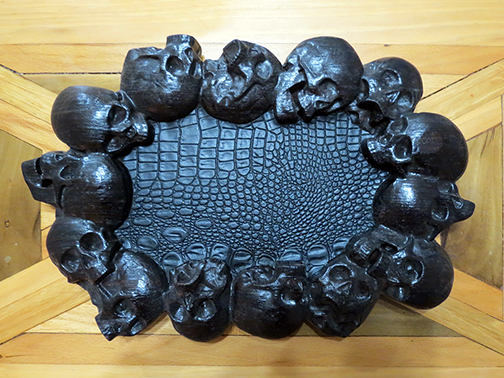
As an example of such a surface, we present an object known as a rolling tray. This particular surface is sculpted from wenge, a dark hard wood of Millettia laurentii, an endangered tree of the Congo, Cameroon, Gabon and Equatorial Guinea. It was crafted by the artisans of Dog Might Games of Ann Arbor, Michigan. The rolling tray is lined with a leather given the appearance of a reptilian beast. The surrounding border of the tray is composed of fourteen skulls, or more precisely fourteen crania and three mandibles.
Traditionally, the identity of these skulls are attributed to the fourteen sacrificial victims‑seven young men and seven maidens‑of the minotaur. As a reminder, the minotaur's labyrinth was located in an abandoned quarry on Crete. The maze had been commissioned by King Minos of Crete, upon the advice of the oracle at Delphi. It is said to have been constructed by Daedalus to hold the minotaur, lest he rampage across the countryside, devouring folk at will. There, every seven years, tribute was made in the form of seven young men and seven maidens, whose lives were forfeit to ward the populace from this scourge.
The first fourteen victims were named thusly.
- Young Men
- Hippophorbas, son of Alypus
- Idas, son of Arcas
- Antimachus, son of Euander
- Menestheus of Sounion
- Amphidocus of Rhamnous
- Demoleon, son of Cydon
- Porphyrion, son of Celeus
- Maidens
- Periboea, daughter of Alcathous
- Melanippe, daughter of Pyrrhus
- Hesione, daughter of Celeus
- Andromache, daughter of Eurymedon
- Eurymedusa, daughter of Polyxenus
- Europe, daughter of Laodicus
- Melite, daughter of Tricorythus
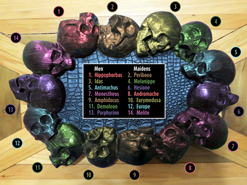 |
|
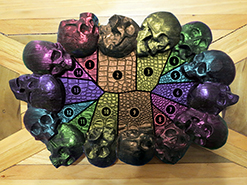 |
In the practice of cleromancy, a group of objects is cast. Often, the arrangement of the stones with respect to each other is sufficient for the diviner to make her predictions. Alternatively, when employing objects marked with runes or numbers, the symbols themselves reveal the forecast. The advantage of using a rolling tray is that it provides an additional source of interpretation, based on the position of the stones within the tray and their proximity to the nearest skull. The irregular polygons identified above divide the area of the tray into fourteen uneven regions, each bordered by a single skull. Any point within a given area is geometrically closer, in the traditional Pythagorean sense, to the adjacent skull than to any other. Today, this space-splitting process is known among mathematicians as Voronoi tessellation, named after the nineteenth-century Ukrainian mathematician, Georgy Voronoy. The interpretation of a stone that came to rest in the area associated with a particular skull adopted an additional meaning or context.
This practice can be likened to astrological natal charts, in which a circle is divided (more or less regularly in this case) into twelve portions corresponding to the signs of the Zodiac. Of course, in astrology, the cast stones are planets and other cosmological bodies. For example, Mars in the house of Gemini possesses quite a different meaning than Mars in the house of any other sign.
So too did the practitioners of this ancient version of cleromancy ascribe different nuances of meaning to a stone which came to rest in the house of Amphidocus or the house of Periboea.
Among practitioners of cleromancy, much greater interest has been placed on the nature of the stones as on the nature on the tray. Although, in this treatise, we have chosen to address the matter of trays first, the length of the section devoted to stones is greater, reflecting their variety. Below, we address several aspects of the stones employed in cleromancy, including material, color, number, entity and ratio. We conclude with a brief comment on stones intended as educational tools for instructing young people in the art of cleromancy.
The objects cast in cleromancy are often referred to as stones, although the actual materials which constitute the objects come from a variety of sources, including stones, beads, shells, sticks, dice or fragments of bone. In the following section, we provide a few examples of stones of varying material composition. Some of these stones retain rough shapes, while others favor geometrically pleasing forms.
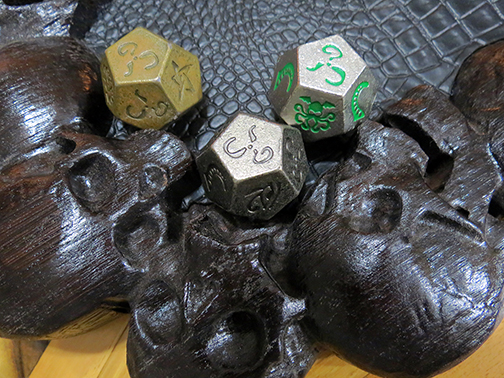
Topmost in the images above are a trio of metal stones, in the much beloved shape of a dodecahedron. These metal dice are manufactured by Steve Jackson of Austin, Texas. Different metals can be used. Here the stones are cast from (left to right) pewter, bronze and nickel. They have been imprinted with symbols taken from Lovecraftian sources.
On the middle left is shown an example of stones made of the volcanic glass, obsidian. The stones are polished and engraved with Elder Futhark runes. These particular examples were purchased from RJ Rock Shop of Oklahoma City, Oklahoma.
On the middle right is shown an example of wooden stones, cut into cubes with rounded corners. Upon the faces of the cubes are printed images from which a story, fictional or predictive, or some combination therein, can be told. When cast within a tray, the influence of the various houses adds context to each element of the emerging narrative. These wooden story dice were sold by Laurence King Publishers of London, England.
On the bottom left is an example of injection-molded polymer (or plastic) dice. One common polymer is PMMA (Polymethyl methacrylate). By convention, a standard set of dice include one four-sided tetrahedron (or trigonal pyramid), a six-sided cube, an eight-sided octahedron, two ten-sided pentagonal trapezohedrons, one marked with units in the ones digit and the other in the tens digit, a twelve-sided dodecahedron and a twenty-sided icosahedron. Such dice are often manufactured in China.
On the bottom right are shown an analogous set of seven dice, cut from jade, a term applied to the naturally occurring mineral, nephrite or Ca2(Mg, Fe)5Si8O22(OH)2. Both jade and obsidian are silicates, but a significant difference is that obsidian is a glass and thus has an amorphous structure whereas nephrite possesses a crystalline structure.
Great significance is attached to the relationship between the color of the stones and the nature of the desired prognostication. Owing to our superficial knowledge of cleromancy, we are not able here to say more than a few passing words of limited value on the subject. Green stones are often used for matters of health and fertility, while red stones are reserved for questions regarding animals, blood and passion. Blue dice are often associated with mysteries of the sea, with quests and with the impossible. Dice that glow in the dark are used for both luminous and clandestine ventures, though for different reasons. These variously colored polymer dice were also manufactured by Steve Jackson
As already hinted at in the introduction to this document, mathematicians and statisticians have their own professional interest in the arts of forecasting and prediction. Their practical accomplishments in this regard border on the astonishing. Although skeptics may point to the inability of statisticians to reliably predict winners of contested political elections or sports championships, that by no means diminishes their successes in other fields, such as stellar phenomena (the appearance of comets, eclipses and other cosmological phenomena) or animal and human population modeling, where predictions can be made with near inevitability.
As such, it should come as no surprise that cleromancers too frequently seek to incorporate numbers and numerology into their own discipline. The standard set of seven die are often decorated with numbers on each face: 1 to 4 for the tetrahedron, 1 to 6 for the cube, 1 to 8 for the octahedron and so on. The presence of two pentagonal trapezohedrons allows for the random generation of numbers between 1 to 10 with one die or 1 to 100 with two.
As is the case with Biblical numerologists, certain numbers are endowed with their own significance. Cleromancers are not unaware of these symbols, emanating from diverse sources, both sacred and profane.
Often the stones contain both symbols and numbers, thus providing a mechanism for the integration of both cleromancy and numerology. The most commonly encountered instance is one where the greatest number on the die is replaced by a symbol, although other conventions exist. For the two examples shown above, the greatest number on each die has been replaced with a stylized star, which is referred to as the Elder Sign and is attributed to August Derleth (1909-1971). As is the case for stones containing purely symbolic runes, these stones also are manufactured in varying materials. Above, metal and polymer stones are shown from the Q-Workshop of Poznań, Poland.
The authentic cleromancer seeks knowledge not from a universal, disembodied repository of information but from a particular individual or entity that occupies some manner of being beyond the physics-based reality. The choice of the spirit, for lack of a more general term, with whom the cleromancer attempts to establish communication is preferably not left to chance. To do otherwise creates the possibility that the spirit thus invoked is poorly disposed to the querent. The retribution of a malevolent spirit disturbed through such processes is the subject of great exaggeration in popular media. Nevertheless, it is advisable to direct one's inquiries as best as one is able.
Stones can be constructed and decorated in a manner so as to channel the intent of the cleromancer to a specific destination. In this section, several examples of such stones are provided. These stones are decorated with colors and symbols, corresponding to the entity to whom the entreaty is directed.
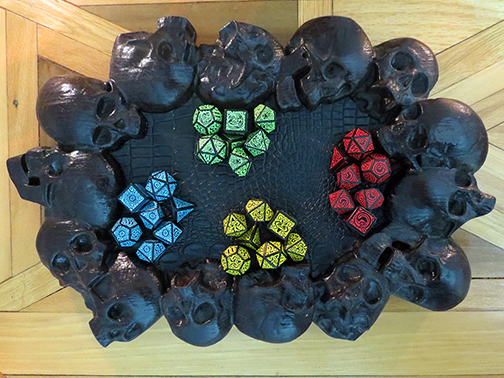
Lest there be any misunderstanding, we should make clear that the personages (e.g. Hippophorbas) invoked in a tray, such as the one described above, are not ordinarily the targets of the divination. On the contrary, they serve in the role of intercessors. At the risk of offending believers, we make an analogy from the saints of the Christian pantheon. Those who choose to pray to saints, do so not with the expectation that the saint themselves will intercede on their behalf. Rather, prayers to saints often explicitly request the aid of the saint in bringing their appeal to the origin of divine power. So too does an invocation to, for example, the sacrificial victims of the minotaur, request the aid of one who has already ventured into the afterworld, in shepherding a request to an entity capable of answering it.
In the example above, the yellow stones are intended for supplication to Hastur, the King in Yellow. The green stones are intended to address Cthulhu, who in death lies dreaming in R'lyeh. The red stones are intended to petition Nyarlathotep, the Crawling Chaos. The blue stones are intended for Azathoth, blind idiot god and Lord of All Things. The consequences of mixing dice of varying color are not fully mapped and, therefore, should not be undertaken except in the most dire need. These entity-specific stones were manufactured by Q-Workshop.
In some instances, many of the design elements described above are combined into a single collection of stones, which invoke the power of colors, symbols, numbers and invocation of entities. Additionally, some sets have, through scholarship hidden from us, arrived at the conclusion that the ratio of the shapes of die should be altered from the traditional seven die, which contain one tetrahedron, one cube, one octahedron, one dodecahedron, one icosahedron and two pentagonal trapezohedrons. We leave it to subsequent chapters to discuss the relevance and impact of the choice of ratio of shapes within a set of stones.
It is often the case, as illustrated in the examples above, the number of six-sided cubic dice has been increased relative to all other shapes. Sometimes three cubes are included. In the images shown above, twelve cubes are included, although it is not necessary that all of them be used during a casting. As was the case with some of the examples given earlier, these stones have an integer assigned to each face of the dice, with the exception of the greatest number, which is replaced with a symbol.
The blue dice again feature the Elder Sign attributed to August Derleth, whereas the green dice are printed with the Elder Sign attributed to H.P. Lovecraft (1890-1937). The red dice replace the greatest number with an image of the tentacled head of Great Cthulhu. These stones were manufactured by Infinite Black of Jemison, Alabama.
As with any tradition, it is important to begin the education of the next generation at an early age. Identification of those youths with an aptitude for cleromancy can be accomplished with child-friendly stones.
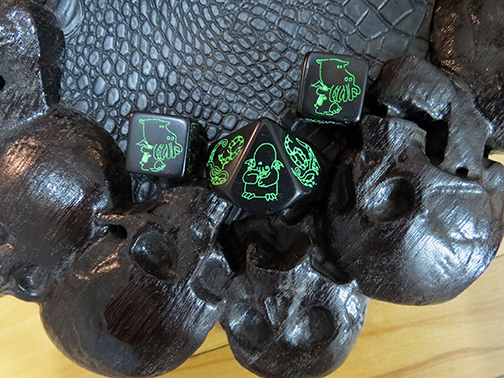
These dice shown above, featuring the ever-adorable cowthulhu, are suitable for divination training and were manufactured by Q-Workshop under license to Steve Jackson Games.
As objects associated with prophecy, the reverence for the entity, to whom the entreaty for wisdom is made, is transferred, mistakenly or not, to the objects of the practice. As a result the stones themselves become venerated, their safe-keeping a matter of some importance. Whereas the wisewoman of old could maintain her bones in a leather pouch strung by a thong around her neck, such mean accommodations are no longer acceptable. In this section, we describe three distinct means of safe-keeping: bags, boxes and cabinetry.
Simple bags made of cloth may suffice to store the stones of cleromancy when they are not in use. The bags can be plain or can be adorned with symbols indicating the purpose of their contents. In the three examples, presented here one bag contains the now familiar astral elder sign. Another has printed upon it an artist's depiction of Great Cthulhu. A third bag is adorned with the image of Cowthulhu. Each of these bags was manufactured by Q-Workshop and was sold with dice of an analogous theme.
Some stone-containers are composed of boxes made of reinforced cardboard. They are designed after the fashion of books, though within one finds not pages but the stones themselves. Unlike words written upon the pages of book, the knowledge hidden with a stone requires a different sort of erudition and is not so easily absorbed as the content of ordinary books. These books are often decorated with images and symbols indicating the nature of the information held within the stones. These boxes were manufactured by Infinite Black.
Some stones are composed of a material that may be damaged (chipped or dented) if they are allowed to rattle against each other in the container. For such dice there exist compartmentalized containers. Certainly, mechanically resilient dice are also stored in such containers by cleromancers with a fondness for ornate paraphernalia. Above we present an example of a wooden box decorated on the exterior with metal trim in the form of the astral Elder Sign amidst a recurring tentacle motif. Within the box, a foam insert is placed, which has been cut to accommodate the traditional set of seven dice. The foam is sufficiently stiff to prevent contact between dice. It is also flexible enough to allow the various polyhedra to fit into the cylindrical niches. This particular box was manufactured by Q-Workshop.
Other wooden boxes are compartmentalized using the same material in which the box itself was made. In this example a red oak (Quercus rubra) box cut in the shape of a hexagon contains in the interior seven hexagonal niches, intended to hold the traditional set of seven dice. This box is held closed by magnets. On the surface it is inscribed with an ornate dragon. Often, dragons, an ancient and long-lived race, are associated with prophecy. Along one facet of the hexagon on the side of the box, the name of the cleromancer is inscribed in Tengwar script of J.R.R. Tolkien.
This box was crafted by Elderwood Academy of Ann Arbor, Michigan.
Many that seek knowledge of the future do so with the aim of acquiring material riches. Such a desire, while not especially lofty, is all the same understandable. As both the wealthy and impoverished know from first-hand experience, life is easier when one is free of financial anxiety. Such visitors to fortune tellers can more readily be convinced of the cleromancer's skills in such endeavors if they perceive some demonstration of wealth.
Cleromancers who service this type of clientele have reason to produce a kind of show. The stones of their trade are therefore stored in glamorous, expensive-looking containers. Often these boxes are manufactured to resemble something akin to treasure chests. Some cleromancers go so far as to line the chest with a bed of coins or paper bills, upon which the stones rest. They can then exploit the fact that those who come to them seeking prognostications related to earthly fortunes generally believe that the gods can be influenced. Stones used for these purposes are best stored among coins and precious metals. The purpose of the coins, presumably is to provide a kind of constant, interminable bribery, which extends into the darkness when the stones are put in storage, for months or years or decades at a time.
The box pictured above was crafted by Dog Might Games of
bubinga (Guibourtia demeusei), a hardwood harvested in the tropical regions of Africa, and highly regarded by luthiers for the making of instruments, such as harps and guitars, because of its mellow and well-rounded sound.
The coins shown above, depicting beasts of the imagination, were designed and struck by the Rare Elements Foundry of Neville, Ohio.
Practitioners with prodigious variety of stones commission furniture makers to build specialized cabinetry for them, in which, like a medicine cabinet, each drawer contains stones intended to address a specific ailment. Where a conventional medicine cabinet may contain herbs to soothe ague, material for a poultice to reduce swelling or a small jar containing an unguent to counter palpitations, the cabinet of the cleromancer contains only a variety of materials intended to serve as divinatory stones. One drawer may contain shells to foretell the fate of one at sea, while inside another we find river pebbles, useful for prognostications regarding the extent of flooding in the upcoming spring. Some drawers may contain teeth or worse, intended for dialogues the nature of which remain beyond our limited scholarship.
This example is the smallest such cabinet, which our party observed while traveling in the Far East. The largest cabinet was indeed an enormous piece of furniture, containing ten times as many drawers as the one shown here. Cabinets such as this one, as well as those much larger, were to be seen in the markets and shops of Insa-dong. They could be purchased individually or in his-and-her matching pairs.
This discussion of the variety of materials associated with cleromancy was written with the intention that it serve as an introductory chapter of a much larger text, focusing on the practice of cleromancy. Unfortunately, the author of the subsequent documents has, upon further reflection, chosen not to publish what she considers to be the secrets of her trade. Moreover, she has further requested that those portions of her manuscript, which she initially shared with us, be immediately destroyed. She has not shared the motivation for her change in heart; we fear that external forces have persuaded her, perhaps by threat of force, to abandon the publication we had sought to achieve.
This work on the material tools of cleromancy has limited value without an accompanying explanation of the intricate mechanisms required to successfully divine the future via cleromancy. Nevertheless, we have presented the document here so that our labors in generating it will not have been entirely wasted.
March 30, 2018
Editor's Update: A Practicum on Divination via Cleromancy has been published as of January, 2020. It is available in its entirely on the website of the Poison Pie Publishing House at the following address: https://www.poisonpie.com/publishing/cleromancy/text/apracticum.html.
January 12, 2020
Noteworthy additions to the tools of cleromancy will be appended to this discussion in a separate addendum.
May 12, 2018
A second addendum titled, Hebeloma's Cleromancy Kits has been posted. This document describes the tools used in the cleromantic ritual as prescribed in the text, A Practicum on Divination via Cleromancy.
February 15, 2020
|
|
|
|

